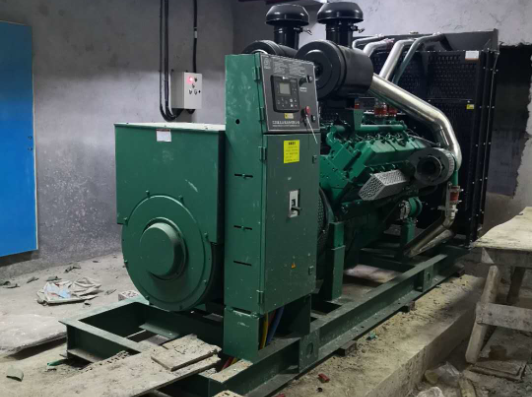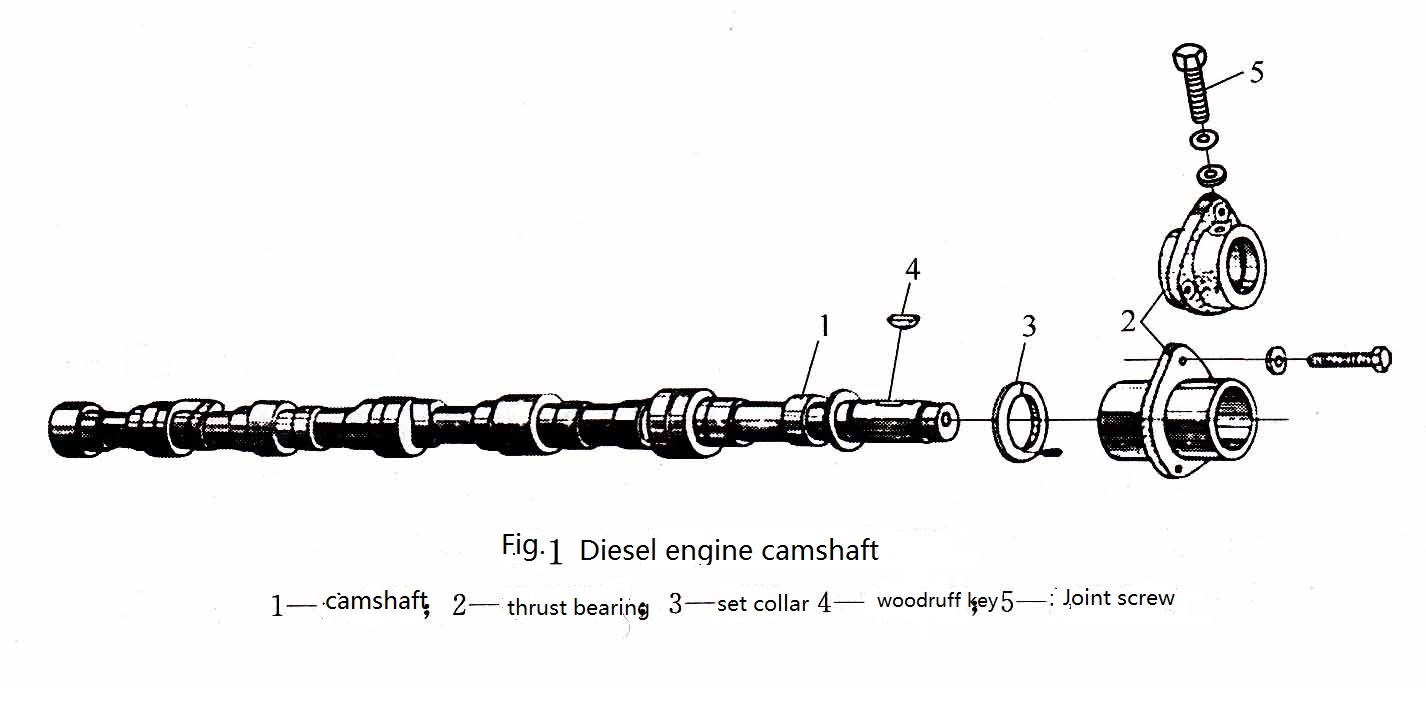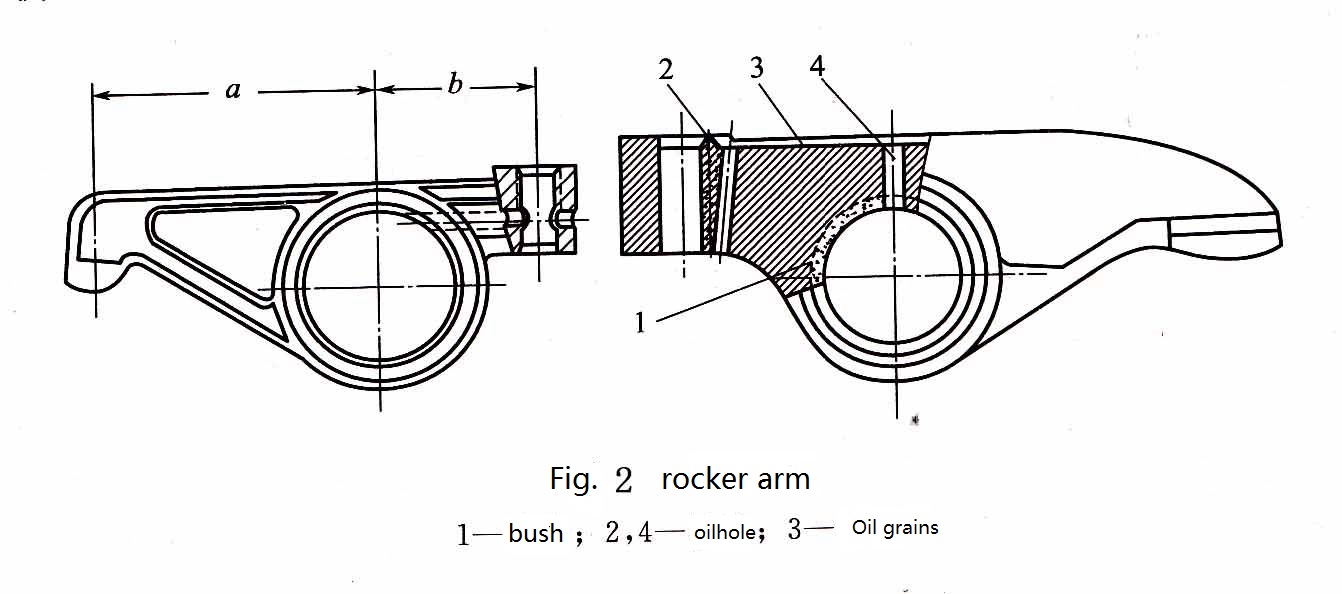What are the components of the diesel generator valve drive group?
Diesel generator valve drive is mainly composed of camshaft, timing gear, tappet, push rod, rocker arm and rocker shaft. The function of the valve train is to open and close the intake and exhaust valves at a specified time (gas timing) and order (fire order), and to ensure a certain degree of opening.

1. Camshaft and timing gear
The camshaft is the main part of the valve train, and the process of opening and closing the valve is mainly controlled by it. The structure of the camshaft is as shown in Fig. 1. It is mainly equipped with a spiral gear or a confidence gear of each cylinder intake and exhaust cam, camshaft journal and drive attachment (such as oil pump). The mutual positions of the cams on the camshaft are arranged in the order of firing specified by the engine. The firing order of the engine can be judged based on the relative positions of the cams and the direction of rotation of the camshaft. In order to ensure that the fuel injection of the diesel engine is reliable on time, the camshaft and the crankshaft must maintain a certain timing relationship.

There is a high contact stress between the cam and the tappet, and the relative sliding speed is also high, and the lubrication condition is poor. Therefore, the working surface of the cam is worn more seriously. Camshafts are generally made of high quality steel. Alloy cast iron and ductile iron casting have been widely used in recent years. Most camshafts are made in one piece, that is, each cylinder intake and exhaust cam is machined on the same shaft.
2. Tappet
The function of the tappet is to transmit the thrust of the cam to the valve or push rod. The tappet is made of steel or cast iron. Generally made into a hollow cylindrical shape.
3. Putt
In the overhead valve mechanism, since the camshaft and the valve are separately provided and the two are far apart, the push rod is used to transmit the thrust transmitted from the camshaft. The putter is generally made of hollow steel pipe to reduce the quality. The ends of the ticket are welded with different shapes of ends. The upper end is concave in shape, and the ball head of the valve rocker adjusting screw is located therein; the lower end is spherical and inserted in the concave spherical seat of the valve tappet. The upper and lower ends are made of steel and heat treated to improve the wear resistance.
4. Rocker arm
The rocker arm is a transmission member between the insurance ticket and the valve, which acts as a lever. The lengths of the arms of the rocker arm are not equal, and the ratio of the long and short arms is about a:b=1.6:1. The long arm end pushes the valve tail end, and under a certain valve opening degree, the maximum lift of the cam can be reduced, and the surface in contact with the valve tail end is made into a cylindrical surface. The rocker arm is usually made hollow, and as a lubricating oil passage, lubricating oil is lubricated from the oil passage of the support through the rocker shaft to both ends of the rocker arm, as shown in FIG. 2 . In order to prevent the axial movement of the rocker arm during operation, a rocker arm spring is arranged between the two rocker arms on the rocker arm shaft.

The role of various parts of the diesel generator set valve group
The gas distribution mechanism of the diesel generator set can be divided into two groups according to its function: a valve group with a valve as a main component and a valve transmission group with a camshaft as a main component.
1. Valve
The valve operates under conditions of high temperature, high mechanical load and difficulty in cooling and lubrication. The valve head is also subjected to gas pressure. The exhaust valve is also subjected to high temperature exhaust gas and is subjected to corrosion by sulfide in the exhaust gas. Therefore, the valve is required to have sufficient strength, high temperature resistance, corrosion resistance and wear resistance.
During compression and combustion, the valve must be tightly sealed and leaks should not occur. Otherwise, the power of the diesel engine will drop. In severe cases, the diesel engine will not be able to start fire due to the low temperature and pressure at the end of compression. The valve works under the condition of air leakage, and the high temperature gas washes the intake valve for a long time, causing the valve to overheat and burn.
The valve is divided into two types: intake valve and exhaust valve. The overhead valve valve distribution mechanism has two valves per cylinder (one intake valve and one exhaust valve), three valves (two intake valves and one exhaust valve), and four valves (two intake valves and two exhaust valves). Door) and five valves (three intake valves and two exhaust valves), two valves are mostly used for medium and small power diesel engines; the latter three are used to strengthen medium and large diesel engines with a high degree of four-valve structure.
Due to the lower working temperature of the intake valve, the alloy steel is generally used, and the exhaust valve is generally made of heat-resistant alloy steel. In order to save costs, sometimes the rod part is made of general alloy steel, and the head is made of heat-resistant alloy steel, and then the two are welded together.
2. Valve Guide
The main function of the valve guide is to ensure the precise concentricity of the valve and the valve seat, so that the valve can reciprocate linearly in the valve guide, and also undertake the task of partial heat transfer. The valve guide works under the high temperature of 250~300 °C and poor lubrication, and is easy to wear. Valve guides are generally made of grey cast iron or ductile iron. In order to prevent the valve guide from falling into the cylinder, a snap ring is embedded in the portion of the cylinder exposed to the cylinder head. There is usually a certain gap between the valve and the valve guide.
3. Valve seat
The main function of the valve guide is to ensure the precise concentricity of the valve and the valve seat, so that the valve can reciprocate linearly in the valve guide, and also undertake the task of partial heat transfer. The valve guide works under the high temperature of 250~300 °C and poor lubrication, and is easy to wear. Valve guides are generally made of grey cast iron or ductile iron. In order to prevent the valve guide from falling into the cylinder, a snap ring is embedded in the portion of the cylinder exposed to the cylinder head. There is usually a certain gap between the valve and the valve guide.
4. Valve seat
The valve seat can be machined directly on the cylinder head or cylinder block. In order to improve the wear resistance of the valve seat surface, separate parts are sometimes made of heat-resistant steel, ductile iron or alloy cast iron, and then pressed into the corresponding holes. This part is called the valve seat. The valve seat is pressed into the seat hole of the cylinder head and can be replaced after wear. Each valve and valve seat must be paired and ground, and the valves cannot be interchanged after grinding.
The material of the valve spring is usually a steel wire of high carbon manganese steel, silicon manganese steel and nickel chromium manganese steel, which is formed by cold rolling and heat treatment. In order to improve the fatigue strength of the spring, it is generally treated by shot peening or sand blasting. The valve of the valve spring is mostly a cylindrical coil spring. Valve springs may resonate during operation, and many diesel engines use two valve springs to prevent resonance. The two inner and outer valve springs are concentrically mounted on one valve, and the spiral direction of the spring is disturbed. When one spring is broken, the other can continue to work, so that the valve does not fall into the cylinder, and the broken part of the spring will not get stuck. In another spring.
5. Valve spring locking device
The valve spring is mounted outside the valve stem portion, one end of which is supported on the cylinder head, and the other end is fixed to the spring seat by the locking device.
Copyright © Guangxi Dingbo Generator Set Manufacturing Co., Ltd. All Rights Reserved | Sitemap
Update cookies preferences